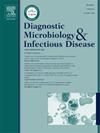Evaluation of the NG-Test® CTX-M MULTI lateral flow immunoassay and genomic discovery of a blaCTX-M-27 variant with a premature stop codon
IF 1.8
4区 医学
Q3 INFECTIOUS DISEASES
Diagnostic microbiology and infectious disease
Pub Date : 2025-07-29
DOI:10.1016/j.diagmicrobio.2025.117034
引用次数: 0
Abstract
Background
Timely identification of extended-spectrum beta-lactamase (ESBL)-producing bacteria supports early antimicrobial optimization, especially for patients with invasive infections. NG-Test® CTX-M MULTI (CTX-M LFA) is a rapid immunochromatographic assay for detection of Cefotaximase-Munich (CTX-M)-type ESBL. We evaluated its performance against existing molecular platforms.
Methods
A sampling of archived Gram-negative bacteria (including Enterobacterales and non-fermenters) was included in the study. All isolates underwent testing for CTX-M ESBL by CTX-M LFA. CTX-M LFA results were compared to results from molecular methods, laboratory-developed (LD)-PCR (2013-2019) or BCID2 (2022-2023). Discordances were resolved with a combination of ESBL phenotypic testing and an alternative PCR platform, or whole-genome sequencing.
Results
Seventy-eight isolates were included in the study, all of which underwent CTX-M LFA and molecular testing (n = 47 by LD-PCR, n = 31 by BCID2). Post-discordance analysis showed positive percent agreement of 89.7 % (95 %CI 71.5-97.2 %), negative percent agreement 100 % (95 %CI 90.9-100 %) and overall categorical agreement 96.2 %, κ=0.92 (95 %CI 88.4-99.0 %). One E. coli was negative by CTX-M LFA but positive for blaCTX-M by BCID2. Whole-genome sequencing identified a non-functional blaCTX-M-27 gene with adenine insertion at position 70 in codon 24, causing a frameshift mutation resulting in a premature stop codon (codon 58).
Conclusion
CTX-M LFA improved performance in comparison with molecular methods by accurately identifying an isolate with a prematurely truncated protein as a true-negative for CTX-M. This highlights potential limitations of molecular-based resistance detection. CTX-M LFA was simple to perform and yielded results within 15 minutes.
NG-Test®CTX-M MULTI横向流动免疫分析法的评估和基因组学发现一个含有过早终止密码子的blaCTX-M-27变异
及时鉴定产生广谱β -内酰胺酶(ESBL)的细菌有助于早期优化抗菌药物,特别是对侵袭性感染患者。NG-Test®CTX-M MULTI (CTX-M LFA)是一种快速免疫层析检测方法,用于检测cefotaxximase - munich (CTX-M)型ESBL。我们对其在现有分子平台上的性能进行了评估。方法采用革兰氏阴性菌(包括肠杆菌和非发酵菌)标本进行研究。所有分离株均采用CTX-M LFA检测CTX-M ESBL。CTX-M LFA结果与分子方法、实验室开发(LD)-PCR(2013-2019)或bccid2(2022-2023)的结果进行比较。通过结合ESBL表型检测和另一种PCR平台或全基因组测序,解决了不一致。结果共纳入78株分离株,均行CTX-M LFA及分子检测(LD-PCR法47株,bccid2法31株)。不一致后分析显示,阳性一致性为89.7% (95% CI 71.5- 97.2%),阴性一致性为100% (95% CI 90.9- 100%),总体分类一致性为96.2%,κ=0.92 (95% CI 88.4- 99.0%)。1株大肠杆菌CTX-M LFA检测为阴性,bccid2检测为blaCTX-M阳性。全基因组测序鉴定出一个无功能的blaCTX-M-27基因,该基因在密码子24第70位插入腺嘌呤,导致移码突变导致过早终止密码子(密码子58)。结论与分子方法相比,CTX-M LFA可以准确地鉴定出CTX-M过早截断蛋白的分离物为CTX-M的真阴性。这突出了基于分子的耐药性检测的潜在局限性。CTX-M LFA操作简单,在15分钟内产生结果。
本文章由计算机程序翻译,如有差异,请以英文原文为准。
求助全文
约1分钟内获得全文
求助全文
来源期刊
CiteScore
5.30
自引率
3.40%
发文量
149
审稿时长
56 days
期刊介绍:
Diagnostic Microbiology and Infectious Disease keeps you informed of the latest developments in clinical microbiology and the diagnosis and treatment of infectious diseases. Packed with rigorously peer-reviewed articles and studies in bacteriology, immunology, immunoserology, infectious diseases, mycology, parasitology, and virology, the journal examines new procedures, unusual cases, controversial issues, and important new literature. Diagnostic Microbiology and Infectious Disease distinguished independent editorial board, consisting of experts from many medical specialties, ensures you extensive and authoritative coverage.

 求助内容:
求助内容: 应助结果提醒方式:
应助结果提醒方式:


